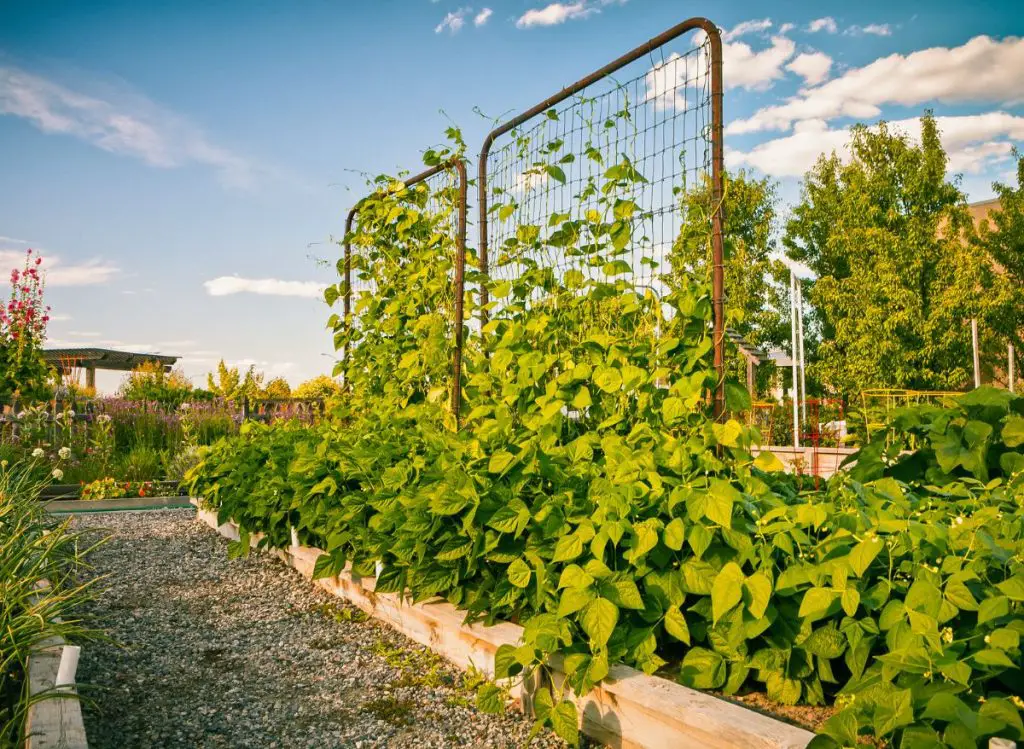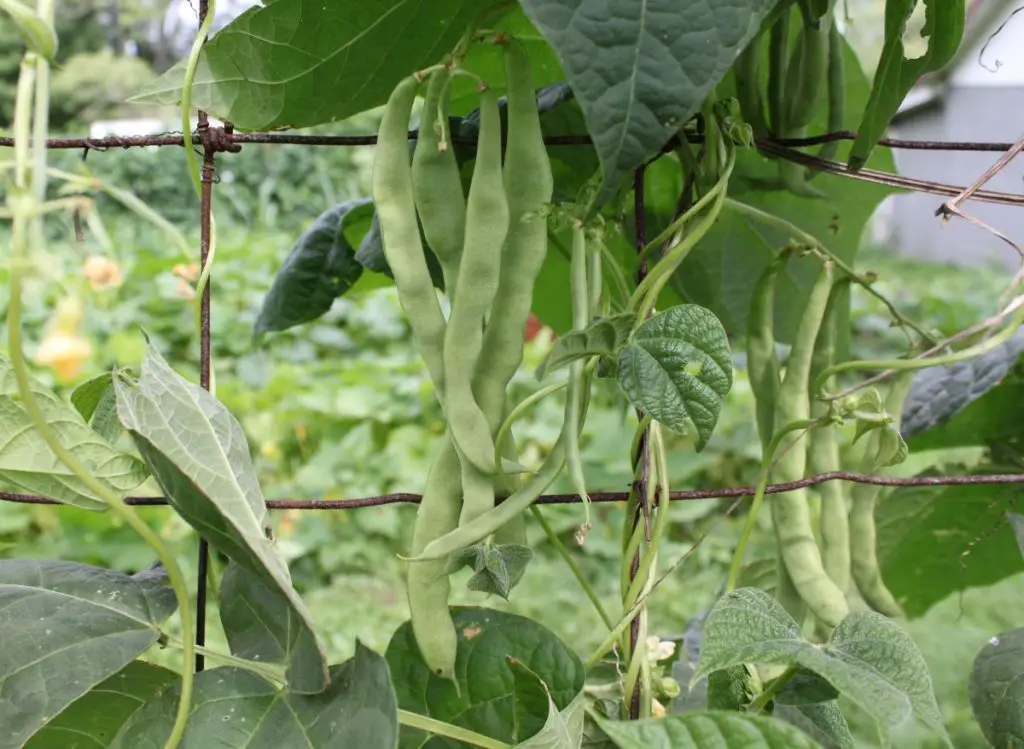
Pole beans are garden plants that can grow into long vines over the course of the summer garden season. The vines will not thrive if allowed to grow along the ground.
Bugs will eat the leaves and the tender beans, and there will be very few beans to harvest if the vines are not kept off the ground.
Pole beans must be supported, and long poles have been the chosen method of support, hence their name. This bean variety produces more beans than its bush variety cousins because the vines continue to grow, bloom, and produce beans throughout the summer.
Continuous production is one reason that pole beans remain a popular choice for gardeners. Flavor, bean size, and heirloom varieties are other reasons that this type of bean has been a favorite for centuries.
If you love pole beans, use these growing tips so they will thrive in your garden.
If you are considering growing Bush Beans and wondering whether bush beans need a trellis, I wrote a whole article about everything you need to know.
What Are Pole Beans?
Pole beans include kidney beans, runner beans, snap beans, yellow wax beans, and string beans; heirloom pole bean varieties such as Blue Lake, Kentucky Wonder, Kentucky Blue, and Held.
Contrary to bush beans, pole beans require support. Before planting pole beans, I suggest setting up a trellis or a teepee to support your pole beans as they grow.
Best Ways To Make Pole beans Thrive.
Pole beans are generally easy to grow; they require little maintenance and care to thrive. Here are the best tips to make pole beans thrive.
1- Choose a Sunny Location
Pole beans need lots of sunshine to thrive. Select a planting location that will receive 6-8 of direct sunlight each day.
Pole beans generally do well in full sun and fertile and well-drained soil. Avoid planting beans before the soil temperature is at a minimum of 60 ºF (Source: Clemson University)
Plant pole bean seeds in cold soil will not germinate well. And even if they do, the plant will be killed by light frost.
If you have a full sun location, that will make the best planting spot.
2- Ensure You Pick Good Soil
While pole beans do not take up much garden soil space, they do need fertile, well-draining soil to thrive.
Turn the soil to loosen it to a depth of 8 inches. Add 2-4 inches of compost on top of the turned soil and lightly work it into the soil. The compost will provide nutrition for the bean plants, prevent soil compaction, promote good drainage, and attract earthworms.
Earthworms improve the soil in many ways and are one of the best friends a gardener can have. The best way to help all of your garden plants thrive is to develop a healthy earthworm population in the soil. Compost will help you do that.
Prepare the soil in late spring but don’t be in a hurry to plant the bean seeds. As a warm-season vegetable, the seeds will not germinate until the soil, and air temperatures have warmed. If the bean seeds are planted into the soil while it’s too cold, the bean seeds will rot, and you will have to re-plant.
Sow seeds directly into the soil in late spring when the soil has warmed to above 55 degrees F. Many vegetable seed varieties can be started indoors, but pole beans are not one of them.
The seeds germinate quickly in just 3-5 days and grow rapidly. Plus, there is a 99% germination rate for viable green bean seeds making it an ideal vegetable for direct sowing.
3- Provide Your Plants With Plenty Of Water
Pole beans are heavy drinkers. They need plenty of water to help the vines and beans to grow. About 2 inches of water each week will be sufficient. water the vines between rain showers and apply it at the soil level.
Avoid getting the leaves wet to help prevent powdery mildew from developing on the vines.
4- Don’t Forget To Apply Mulch
Applying mulch to your pole bean can help your plants in many ways. Mulching offers tremendous benefits. About 10 to 25% of the water in the soil is lost to evaporation, and mulch can help slow evaporation and reduce the amount of watering required.
In addition, mulch acts as an insulating blanket by lowering soil temperatures in hot weather and protecting pole beans’ shallow roots from the cold temperatures of winter.
Organic mulches improve the condition of the soil and provide a source of plant nutrients and create an ideal environment for earthworms and other soil organisms.
The best time to mulch is late spring after the soil has warmed. However, using mulch too early may delay soil warming and possibly plant growth. In most cases, I recommend using two to three inches of mulch.
Apply a 2-inch layer of mulch on top of the soil after the bean plants are 6 inches tall. Mulch will help the soil retain moisture and prevent weed growth. The mulch will also slowly decompose, add nutrients to the soil, and improve soil structure.
Use shredded tree bark, straw, compost, or other organic material as mulch. Keep the mulch 2 inches away from the base of the stem.
5- Leave Enough Overhead Space
Pole beans do not take up much ground space in the garden. However, the vines will need lots of overhead space to grow. A small 4 feet by 4 feet raised bed is enough soil space to grow 32 pole bean vines. That many vines will produce several bushes of garden fresh green beans over the course of the summer growing season.
Pole beans can be planted 6 inches apart and have companion small plants, like radishes, grown in between the vines. The vines will grow long and will need a support system that will keep them off the ground.
The overhead space should be a comfortable height for you to reach when harvesting the pole beans. The vines can reach up to 15 feet in length and will need to be trained on poles or other structures, so they remain within harvesting height.
You might also enjoy reading: Everything You Need to Know Before Starting Green Beans Indoors.

6- Create An Overhead Trellis
Most gardeners growing pole beans use poles about 6 feet tall and build an overhead trellis for the vines. The beans vines grow up the pole and onto the trellis. As the beans develop, they hang down from the trellis, and harvesting the green beans is made easy.
Wood posts, metal fence posts, bamboo, or something similar make ideal poles. Place one pole securely into the garden soil near a bean plant.
Create a trellis that lays across the tops of the poles with chicken wire, lattice panels, or something similar. The top trellis needs to have holes that will allow the beans to hang down and air to circulate. The pole beans will naturally grow up and over the trellis.
If you don’t want to create a trellis system, pole bean vines will happily grow along a fence, on an outdoor clothesline, or up corn stalks.
Pole beans generally need a support structure to thrive, with stems growing to as much as 15 inches (38.1 cm) in length (Source: Missouri Botanical Garden)
7- Leverage Companion Gardening Method
You can practice companion planting to prevent pests such as Mexican bean beetles and aphids. A companion gardening method known as the Three Sisters plants pole beans, corn, and squash together for mutual benefits and to save space.
The bean vines grow up the corn stalks and help anchor the shallow-rooted corn in the soil; the corn provides a sturdy support system for the bean vines, and the squash is given a little shade by the corn and beans plus the large squash leaves shade the soil to keep the shallow corn roots cool and prevent weed growth.
8- Warm-Season Annual
Pole beans are a warm-season annual garden crop that will go from seed time to harvest time in 60-70 days.
Their fast growth rate will allow you to plant two crops yearly – one in the late spring and the second crop in late summer.
9- Practice Crops Rotation
Practice crop rotation if you plant two crops in a year and don’t re-plant the pole beans in the same spot. All vegetable crops should be planted on a 3-year rotation in which the same plant is not grown in the same spot for at least 3 years.
If crops are planted in the same spot year after year, it depletes the soil of specific nutrients needed by that plant and allows plant-specific pests to multiply rapidly and destroy the crop.
For example, cutworms love green bean plants, both the pole and bush varieties. Cutworms lay their eggs in the soil, and each year, there will be an increased number of cutworms if pole beans are planted in that location.
In a few years, you will not be able to grow pole beans (tomatoes, potatoes, cabbage, carrots, etc.) in that spot because of the abundant cutworm population.
Crop rotation is one of the best ways to help pole beans thrive.
Growing Pole Beans
Growing pole beans will provide you with a fresh food source all summer and a beautiful, blooming vine that will attract pollinators to your garden.
They are as easy to grow as any other vegetable; they just need a little support to hold them up off the ground.
What to read next:

